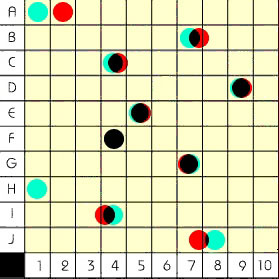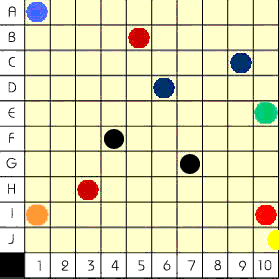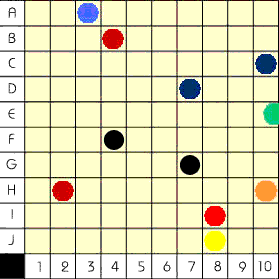Positioning of the Stereo Window and Window Violation
A stereo window violation occurs when an object appears in front of the stereo window and is cut off by the window. It’s a physical impossibility that a window frame, seemingly appearing behind the object, is able to obscure it. Usually, this paradox cannot be well processed by our brains and such an image hurts our eyes (see the yellow dot on the diagram below). Window violations should be avoided, especially on the left and right edges of a stereogram, where this spatial conflict seems to be the most acute. When an object is in front of the window but does not touch the window edges, it makes a “through the window effect” and not a window violation (see the red dots below). Through the window effect often gives more dramatic appearance to a 3d photo and makes it more interesting to view.
The diagrams below were designed to explain the stereo window violations of perfectly aligned chips in vertical direction, and gives some advice on mounting the chips. Various colored circles are located either closer or further than the window frame. Black circles are at the same relative positions in both chips, so they are even with the stereo window. Red, orange and yellow are in front of the frame. Please analyze their relative positions in both chips carefully because these are the only circles that may actually violate the stereo window.
Parallel
|
|
|
Cross-eye
|
|
The red circles are closer but they are entirely visible in both chips, so they are not violating the frame (they are only 'through the window'). Orange are monocular objects (undesirable) and the yellow spot violates the window. To prevent window violations you should align both chips in such a way that all the details of an object that is in front of the window are visible in the left and right chip. The green circle is located behind the stereo window, so it is not violating it, despite that only half of the circle is visible on the right chip. An excellent stereogram should not have even those problems, that is, avoid significant, eye catching, objects to be shown only in one chip even if it's behind the window.
The diagram in the anaglyph format (below) shows only black circles for simplicity, however they are differently positioned relative to the stereo window. The left eye sees the diagram through the red filter and the right eye through blue or cyan. Therefore, the red circles are supposed to be seen only by the right eye, perceived as black. Note that if the red part of the circle is positioned to the left of the cyan circle, the black (cumulative) object appears in front of the window. Please pay the closest attention to those objects because window violations (w.v.) can be created with objects in front of the stereo window only. The example below shows none because no objects are cut in half (the cyan spot in H1 is not desirable because it shows up only in the red channel, but it does not create w.v.) It is commonly accepted that stereograms in the anaglyph format should also look pleasantly when viewed without blue/red glasses, and that is considered even more important to some, than the window violations. Many stereographers position the most questionable objects (with strong ghosting) at the window level, such as the F4 dot, so that the blue or red counterparts of those objects don't exist.
Anaglyph
![]() ________
________ ________
________![]()
Below is the example of vertical misalignment. Although it is still possible to see the diagram in stereo, it is harder and less comfortable to do so. Small rotational misalignments are more difficult to spot because usually only one side of the picture has visible vertical positioning problems than the other (not shown here).
Cross-eye
|
a |
|
© 2003-8 PikesPeakPhoto. All rights reserved.

